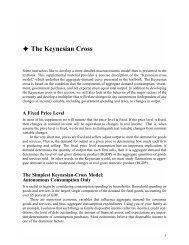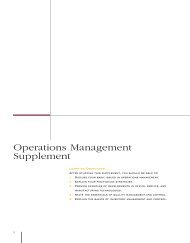chapter 8: strategy formulation and implementation
chapter 8: strategy formulation and implementation
chapter 8: strategy formulation and implementation
You also want an ePaper? Increase the reach of your titles
YUMPU automatically turns print PDFs into web optimized ePapers that Google loves.
investment portfolio with some high-risk stocks, some low-risk stocks, some<br />
growth stocks, <strong>and</strong> perhaps a few income bonds. In much the same way, corporations<br />
like to have a balanced mix of business divisions called strategic<br />
business units (SBUs). An SBU has a unique business mission, product line,<br />
competitors, <strong>and</strong> markets relative to other SBUs in the corporation. 47<br />
Executives in charge of the entire corporation generally define the gr<strong>and</strong> <strong>strategy</strong><br />
<strong>and</strong> then bring together a portfolio of strategic business units to carry it<br />
out. One useful way to think about portfolio <strong>strategy</strong> is the BCG matrix.<br />
The BCG Matrix<br />
The BCG (for Boston Consulting Group) matrix is illustrated in Exhibit 8.5.<br />
The BCG matrix organizes businesses along two dimensions—business<br />
growth rate <strong>and</strong> market share. 48 Business growth rate pertains to how rapidly<br />
the entire industry is increasing. Market share defines whether a business unit<br />
has a larger or smaller share than competitors. The combinations of high <strong>and</strong><br />
low market share <strong>and</strong> high <strong>and</strong> low business growth provide four categories<br />
for a corporate portfolio.<br />
The star has a large market share in a rapidly growing industry. The star is<br />
important because it has additional growth potential, <strong>and</strong> profits should be<br />
plowed into this business as investment for future growth <strong>and</strong> profits. The star<br />
is visible <strong>and</strong> attractive <strong>and</strong> will generate profits <strong>and</strong> a positive cash flow even<br />
as the industry matures <strong>and</strong> market growth slows.<br />
The cash cow exists in a mature, slow-growth industry but is a dominant<br />
business in the industry, with a large market share. Because heavy investments<br />
in advertising <strong>and</strong> plant expansion are no longer required, the corporation<br />
earns a positive cash flow. It can milk the cash cow to invest in other, riskier<br />
businesses.<br />
Business<br />
Growth<br />
Rate<br />
Stars<br />
Rapid growth <strong>and</strong><br />
expansion.<br />
Cash Cows<br />
Milk to finance question<br />
marks <strong>and</strong> stars.<br />
Formulating Corporate-Level Strategy 15<br />
High Market Share<br />
Low Exhibit<br />
High<br />
Low<br />
Question Marks<br />
New ventures. Risky—a few<br />
become stars, others are<br />
divested.<br />
?<br />
Dogs<br />
No investment. Keep if<br />
some profit. Consider<br />
divestment.<br />
portfolio <strong>strategy</strong><br />
A type of corporate-level <strong>strategy</strong> that pertains<br />
to the organization’s mix of SBUs <strong>and</strong><br />
product lines that fit together in such a way<br />
as to provide the corporation with synergy<br />
<strong>and</strong> competitive advantage.<br />
strategic business unit (SBU)<br />
A division of the organization that has a<br />
unique business mission, product line, competitors,<br />
<strong>and</strong> markets relative to other SBUs<br />
in the same corporation.<br />
BCG matrix<br />
A concept developed by the Boston<br />
Consulting Group that evaluates SBUs with<br />
respect to the dimension of business growth<br />
rate <strong>and</strong> market share.<br />
The BCG Matrix<br />
8.5










